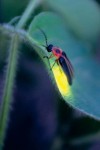Learning From Nature – Improving LEDs
This is NOT a religious rant so please bear with me.
 Two Jehovah’s Witnesses dropped by the other day and left after a short time, leaving me with copies of their two publications – Awake! and The Watchtower.
Two Jehovah’s Witnesses dropped by the other day and left after a short time, leaving me with copies of their two publications – Awake! and The Watchtower.
As I deposited them on the kitchen table I noticed on the back page of the February 2014 issue of Awake! a story entitled The Lantern of the Photuris Firefly.
Well naturally the word lantern caught my eye plus the fact that fireflies are prevalent in the Philippines where I am living right now.
Interesting story, and very interesting how scientists adapted it to modern day Light Emitting Diode (LED) technology which is used in your el-cheapo flashlights up to modern high-intensity LEDs for beacons and marker lamps of all sorts used in lighthouses and light beacons.
Especially take note of the fact:
. . . scientists coated LEDs with a corrugated surface similar to that of the firefly’s lantern. The result? The LEDs emitted up to 55 percent more light!
Instead of repeating the story below, please follow the link. It is a short and worthwhile read.
Also in PDF format here.
[private]
Awake! February 2014
WAS IT DESIGNED?
The Lantern of the Photuris Firefly
THE lantern, or light organ, of a particular Photuris firefly is covered with jagged scales that dramatically enhance the brightness of the light that the insect produces.
Consider: Researchers have found that tiny scales on the lantern surface of some fireflies form a corrugated pattern, somewhat like overlapping shingles or tiles. The scales tilt up at one end by just 3 micrometers—less than one twentieh the thickness of a human hair. Yet this tiny tilt lets the lantern shine almost 50 percent more brightly than it would if the scales formed an even surface!
Could that concept improve the efficiency of light-emitting diodes (LEDs), which are used in electronic devices? To find out, scientists coated LEDs with a corrugated surface similar to that of the firefly’s lantern. The result? The LEDs emitted up to 55 percent more light! Physicist Annick Bay says: “The most important aspect of this work is that it shows how much we can learn by carefully observing nature.”
What do you think? Did the lantern of those Photuris fireflies come about by evolution? Or was iit designed?
Scientists have not studied all species of this firefly.[/private]